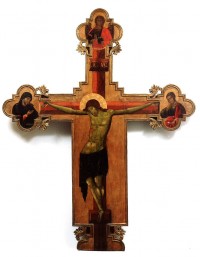 After more than six decades on the lam, a 14th century crucifix panel painting attributed to Paolo Veneziano returned home on Monday, March 11th. Painted between 1335 and 1345 in the Gothic style made famous by Florentine masters Giotto and Cimabue, the crucifix is more than nine feet high and eight feet wide. The crucified Christ is the central figure, with the Virgin Mary looking sorrowfully at her son from the right of the crossbar and Saint John from the left. An angel painted above the cross looks straight out at the viewer.
After more than six decades on the lam, a 14th century crucifix panel painting attributed to Paolo Veneziano returned home on Monday, March 11th. Painted between 1335 and 1345 in the Gothic style made famous by Florentine masters Giotto and Cimabue, the crucifix is more than nine feet high and eight feet wide. The crucified Christ is the central figure, with the Virgin Mary looking sorrowfully at her son from the right of the crossbar and Saint John from the left. An angel painted above the cross looks straight out at the viewer.
It was removed from the Church of San Pantaleone Martyr in Venice at the end of World War II. Although most of the articles vaguely allude to Germans stealing it on their way out of occupied Italy, it seems they weren’t marauders so much as receivers of stolen goods. According to Edward B. Garrison’s 1959 book Italian Romanesque Panel Painting, it was the parish priest himself who illegally sold the masterpiece to German troops to raise desperately needed money for his war-ravaged community.
Consider its massive size, it’s quite remarkable that the painting remained intact during its smuggling travels. It touched down in Rome and France before winding up in a private collection in Germany. Last year, the collector consigned the crucifix to the Lempertz auction house in Cologne. When Lempertz experts investigated the ownership history of the piece, they realized it was never legitimately sold.
With the crucifix’s presence in the market the result of theft and considering its unique cultural importance, Lempertz did something I have never seen an auction house do: they bought it from the seller at cost and donated it to the Church of San Pantaleone. That is some gift. Medieval painted crucifixes are rarer than hen’s teeth on the market, and one of such massive size and quality is practically unheard of. The auctioneers were of course fully aware of what they were losing, but they made a conscious decision to make the ethical choice rather than ride willful blindness all the way to the bank like so many auction houses before them have done.
“It’s a work that has no equal in the market,” says the Lempertz specialist in Old Master Paintings Mariana M. de Hanstein. “If it didn’t have the history it has, the pre-sale estimate would probably be around 700,000 euros. But this is a work that cannot be sold. It is a moral issue. It does not belong to the market, but to a large international museum.”
The managing partner of Lempertz Henrik Hanstein said: “In the beginning we were excited about the delivery of a work of Venetian painting from the fourteenth century of such quality. But then it became immediately clear to us: this work does not belong in an auction but to its original home, the church that Venetians with their wonderful dialect called San Pantaleon. We are happy to be able to return so significant a work to the city of Venice, to which we are grateful for so much extraordinary art.”
Note to self: when you hit the lottery, go buy all your stuff at Lempertz.
On November 17th, a ceremony was held in Cologne officially returning the painting to Venice. Before the Archbishop of Cologne Cardinal Joachim Meisner, Italian consul Eugenio Sgrò, Italian ambassador Elio Menzione, the crucifix was formally handed over to Monsignor Francesco Moraglia, Patriarch of Venice. Before settling down permanently in Venice’s ever-loving arms, however, the masterpiece made one more stop. From February 15th until the end of the month, it stood in the place of the papal throne in the Sala Clementina of the Apostolic Palace in Vatican City. On February 28th, it witnessed Pope Benedict XVI’s final address to the College of Cardinals before his formal abdication and departure to Castel Gandolfo.
Now that the crucifix is in Venice, it is being examined by conservators. Once it gets a clean bill of health, the painting will be moved back to the Church of San Pantaleone Martyr.
This painting almost looks byzantine, doesn’t it ? – Thus, he who says ‘alpha’, must also say ‘omega’ (or something like that), and there is also some Greek on top of the panel: IC = Iota (Ι) and Sigma (ς) = Jesus (Ιησους), and XC = Chi (Χ) and Sigma (ς) = Christ (Χριστος). BTW, 9ft = 2.7432 m ? That’s indeed massive ! Also, even if this work belongs to the seemingly much more recent ‘San Pantaleon’, Lempertz could also have donated the piece to the 10th century St. Pantaleon’s Church in Cologne itself. Therefore, I wonder if letting it witness Benedict’s final address was some sort of PR stunt.
They weren’t just “donating” the work, they were returning it to its original home. If it is PR, its very good PR. I’ll remember them.
Thank you for posting. I am taking a class on this, and your blog has helped me immensely :yes: . Very well written and very informative!!
You’re taking a class on medieval art or art theft or … ?
Curious, any of the history buffs on here know anything about http://www.theosophistsociety.org/index.html. I messaged the writer of the blog. I was curious, about getting information on this. Can you guys lead me in the right direction?
😀 🙂 :p